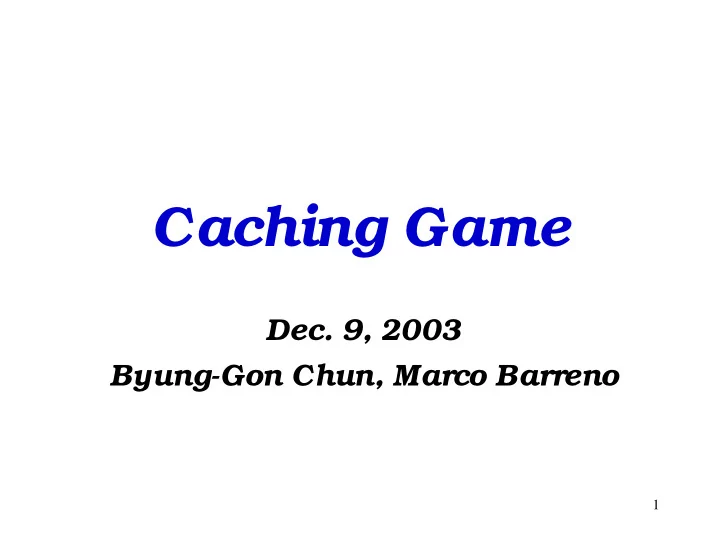

Caching Game Dec. 9, 2003 Byung-Gon Chun, Marco Barreno 1
Contents • Motivation • Game Theory • Problem Formulation • Theoretical Results • Simulation Results • Extensions 2
Motivation Server Server Server Server Wide-area file systems, web caches, p2p caches, distributed computation 3
Game Theory • Game – Players – Strategies S = (S 1 , S 2 , …, S N ) – Preference relation of S represented by a payoff function (or a cost function) • Nash equilibrium – Meets one deviation property – Pure strategy and mixed strategy equilibrium • Quantification of the lack of coordination – Price of anarchy : C(WNE)/C(SO) – Optimistic price of anarchy : C(BNE)/C(SO) 4
Caching Model • n nodes (servers) (N) • m objects (M) • distance matrix that models a underlying network (D) • demand matrix (W) • placement cost matrix (P) • (uncapacitated) 5
Selfish Caching • N: the set of nodes, M: the set of objects • Si: the set of objects player i places S = (S1, S2, …, Sn) • Ci: the cost of node i 6
Cost Model • • Separability for uncapacitated version – we can look at individual object placement separately – Nash equilibria of the game is the crossproduct of nash equilibria of single object caching game. 7
Selfish Caching (Single Object) • Si : 1, when replicating the object 0, otherwise • Cost of node i 8
Socially Optimal Caching • Optimization of a mini-sum facility location problem • Solution: configuration that minimizes the n ∑ total cost ( ) c s i = i 1 • Integer programming – NP-hard 9
Major Questions • Does a pure strategy Nash equilibrium exist? • What is the price of anarchy in general or under special distance constraints? • What is the price of anarchy under different demand distribution, underlying physical topology, and placement cost ? 10
Major Results • Pure strategy Nash equilibria exist. • The price of anarchy can be bad. It is O(n). – The distribution of distances is important. – Undersupply (freeriding) problem • Constrained distances (unit edge distance) – For CG, PoA = 1. For star, PoA ≤ 2. – For line, PoA is O(n 1/2 ) – For D-dimensional grid, PoA is O(n 1-1/(D+1) ) • Simulation results show phase transitions, for example, when the placement cost exceeds the network diameter. 11
Existence of Nash Equilibrium • Proof (Sketch) 12
Price of Anarchy – Basic Results 13
Inefficiency of a Nash Equilibrium α -1 n/2 nodes n/2 nodes C(WNE) = α + ( α -1)n/2 C(SO) = 2 α α + α − ( 1 ) / 2 n PoA = α 2 14
Special Network Topology • For CG, PoA = 1 • For star, PoA ≤ 2 15
Special Network Topology • For line, PoA = O(n 1/2 ) 16
Simulation Methodology • Game simulations to compute Nash equilibria • Integer programming to compute social optima • Underlying topology – transit-stub (1000 physical nodes), power-law (1000 physical nodes), random graph, line, and tree • Demand distribution – Bernoulli(p) • Different placement cost and read-write ratio • Different number of servers • Metrics – PoA, Latency, Number of replicas 17
Varying Placement Cost 18 (Line topology, n = 10)
Varying Demand Distribution 19 (Transit-stub topology, n = 20)
Different Physical Topology 20 (Power-law topology (Barabasi-Albert model), n = 20)
Varying Read-write Ratio Percentage of writes 21 (Transit-stub topology, n = 20)
Questions? 22
Different Physical Topology 23 (Transit-stub topology, n = 20)
Extensions • Congestion – d’ = d + β (#access) → PoA ≤ α / β • Payment – Access model – Store model [Kamalika Chaudhuri/Hoeteck Wee] => Better price of anarchy from cost sharing? 24
Ongoing and future work • Theoretical analysis under – Different distance constraints – Heterogeneous placement cost – Capacitated version – Demand random variables • Large-scale simulations with realistic workload traces 25
Related Work • Nash Equilibria in Competitive Societies, with Applications to Facility Location, Traffic Routing and Auctions [Vetta 02] • Cooperative Facility Location Games [Goemans/Skutella 00] • Strategyproof Cost-sharing Mechanisms for Set Cover and Facility Location Games [Devanur/Mihail/Vazirani 03] • Strategy Proof Mechanisms via Primal-dual Algorithms [Pal/Tardos 03] 26
Recommend
More recommend